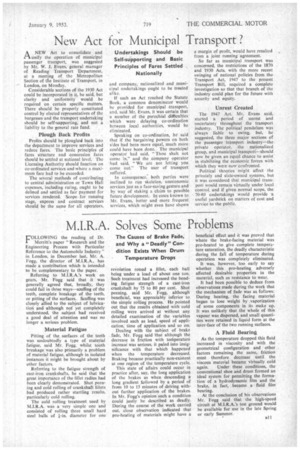MIRA Solves Some Problems
Page 45

If you've noticed an error in this article please click here to report it so we can fix it.
COLLOWING the reading of Dr.
Merritt's paper "Research and the Engineering Process with Particular Reference to the Automobile Industry" in London, in December last, Mr. A. Fogg, the director of M.I.R.A.. has made a contribution which is intended to be complementary to the paper.
Referring to M.I.R.A.'s work on gears, Mr. Fogg said that it was generally agreed that, broadly, they could fail in three ways—scuffing of the teeth, complete breakage of the teeth, or pitting of the surfaces. Scuffing was closely allied to the subject of lubrication and although not yet completely understood, the subject had received a good deal of attention and was no longer a serious problem.
Material Fatigue
Pitting of the surfaces of the teeth was undoubtedly a type of material fatigue, said Mr. Fogg, whilst tooth breakage was also primarily a problem of material fatigue, although in isolated instances it might be brought about by other factors.
Referring to the fatigue strength of cast-iron crankshafts, he said that the great importance of the fillet radius had been clearly demonstrated. Shot peening and cold rolling of crankshaft fillets had prciduced rather startling results. particularly cold rolling.
The cold rolling treatment used by M.I.R.A. was a very simple one and consisted of rolling three small hard steel balls of i-in. diameter for one
revolution round a fillet, each ball being under a load of about one ton. Such treatment had increased the bending fatigue strength of a cast-iron crankshaft by 75 to 80 per cent. Shot peening. said Mr. Fogg, although beneficial, was appreciably inferior to the simple rolling process. He pointed out that the results obtained with cold rolling were arrived at without any detailed examination of the variables involved such as load, speed of application, time of application and so on.
Dealing with the subject of brake fade, Mr. Fogg said that although the decrease in friction with ternperature increase was serious, it paled into insignificance with that which happened when the temperature decreased. Braking became practically non-existent at one region of the temperature cycle.
This state of affairs could occur in practice after, say, the long application of the brakes as when descending a. long gradient followed by a period of from 10 to 15 minutes of driving without further application of the brakes. In Mr. Fogg's opinion such a condition could justly be described as deadly. During the course of the work carried out, close observation indicated that pro-heating of materials might have a
beneficial effect and it was proved that where the brake-facing material was pro-heated to give complete temperature saturation, the deadly characteristic during the fall of temperature during operation was completely eliminated.
It was, however, to early to say whether this pro-heating adversely affected desirable properties in the material, such as resistance to wear.
It had been possible to deduce from observations made during the work that the mechanism of fade was as follows: During heating, the facing material began to lose weight by ,vaporization of some components in its make up. It was unlikely that the whole of this vapour was dispersed, and small quantities were retained in liquid form at the inter-face of the two running surfaces.
A Fluid Bearing
As the temperature dropped this fluid increased in viscosity and with the geometrical configuration and other factors remaining the same, friction must therefore decrease Until the viscous material became virtually cold again. Under these conditions, the conventional shoe and drum formed an ideal system for permitting the formation of a hydrodynamic film and the brake, in fact, became a fluid film bearing. At the conclusion of his observations Mr. Fogg said that the high-speed circuit at M.I.R.A.'s test ground would be available for use in the late Spring or early Summer.












































































































































































